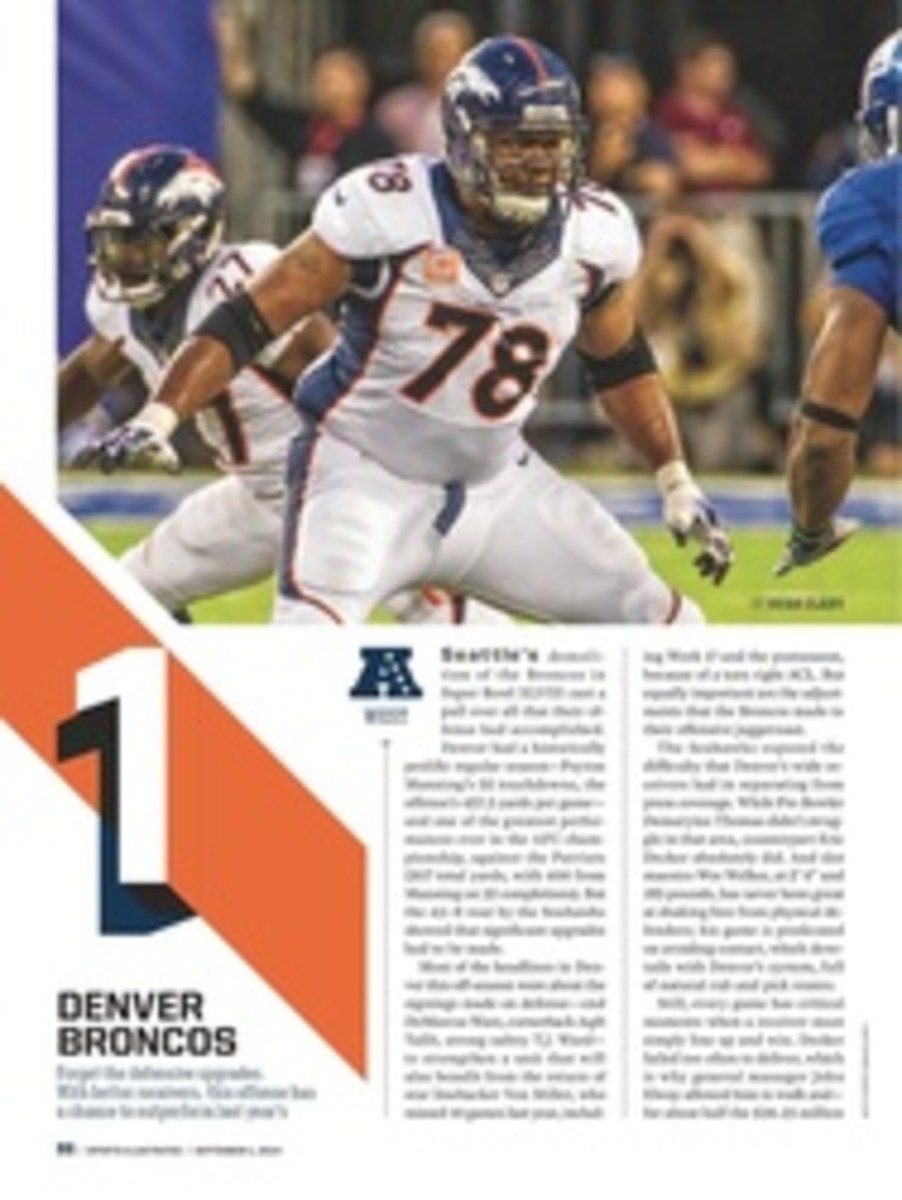
1 NEW ENGLAND PATRIOTS
With one addition in the secondary, Bill Belichick's D turned a huge corner. Now, beware the man-free lurk
Darrelle Revis knows the value of a shutdown corner. He held out as a first-round draft pick for the Jets in 2007, then as an established superstar in '10 and, basically, again in '13, when he forced a trade to the Buccaneers. Each time he came away with major money. After his release from Tampa last March, Revis surveyed the scene and landed a sweet deal with the Patriots: $12 million for one year, with a $20 million team option in '15 and a clause that prohibits the franchise tag.
Tip your cap to the 29-year-old. The NFL is the most cutthroat of businesses, and Revis has repeatedly gotten the most out of negotiations with billionaire-owned organizations adept at protecting their own interests.
So why, exactly, is Revis so successful? What's his leverage? You've heard that he's a shutdown corner, but what does that really mean?
The answer starts here: Revis can single-handedly eliminate an opponent's best receiver in man coverage. This significantly constricts an offense—especially a pass-oriented one. But the hidden benefits of a shutdown corner are even more extraordinary. It's not just that Revis is able to take the No. 1 receiver out of a game—it's that the other 10 defenders know he can. This allows them to ignore Revis's area and put all their energy into a smaller field. It's simple geometry: The less area each defender has to account for, the more they can all swarm. This is how defenses "play fast."
New England coach Bill Belichick is clearly eager to build upon the man-coverage concepts that his defense has run almost exclusively over the past several years. In addition to signing Revis, he brought in former Seahawks cornerback Brandon Browner, a king-sized press-man maven who flourishes when playing to his help coverage. Browner will miss the first four games for violating the league's substance-abuse policy, but the Pats still have a rich stable of reserve corners: veteran Kyle Arrington, second-year playmaker Logan Ryan and budding outside stopper Alfonzo Dennard.
Many teams play man-to-man behind some form of blitz—but blitzes are not high on Belichick's list. His image as a mad-genius defensive schemer to the contrary, he prefers a sound, safe, coverage-based approach. Belichick's man-to-man is likely to place one safety over the top, with the other roving underneath. This coverage, called man-free lurk, is ripe for disguises and rotational switches if a coach is so inclined.
With Revis and rangy free safety Devin McCourty (a converted first-round corner), the Patriots have the key ingredients for man-free lurk. And, instead of always using either of two young strong safeties, Duron Harmon or Tavon Wilson, as the lurker, they can employ second-year linebacking stud Jamie Collins. A former high school quarterback who played safety, linebacker and defensive end at Southern Miss, Collins has the athleticism to blanket tight ends, read-and-react fluidly from zone, rush the passer and defend the run, both as a chaser and as an edge setter. Simply put, he's a 6'3", 250-pound chameleon with a chance to be a top 10 NFL defender.
Joining Collins at linebacker is Jerod Mayo, a talented, multidimensional veteran who missed 10 games last year with a torn right pectoral muscle, and Dont'a Hightower, an effective run stopper but only a mediocre pass defender. Hightower will come off the field in throwing situations, when Belichick's big concern will be whether his four-man pass rush can generate even a little heat on the passer.
Sinewy Chandler Jones had 11½ sacks last season thanks in large part to his agility in confined areas. But Jones is not a terrifying speedster off the edge. Nor is fellow defensive end Rob Ninkovich. And backup Will Smith, a free-agent pickup who missed all of 2013 with a left-ACL tear, may not have much left in the tank. Hoping to ramp up the pressure inside, the Patriots used a first-round pick on gap shooter Dominique Easley (Florida), who they imagine will rotate with tackles Vince Wilfork (coming off an Achilles injury)and Chris Jones (just a guy) once Easley's surgically repaired knee is healthy.
If the pass rush does turn out to be anemic, Belichick may need to bolster it with blitzers. Failing that, he'll have to lean almost entirely on his secondary. Most likely, the Mount Rushmore coach will do a little bit of both.
Flexibility, after all, is another advantage that comes with signing a shutdown cornerback.
2014 SCHEDULE
2013 Record: 12--4
WEEK 1
MIA [AWAY]
MIN [AWAY]
OAK [HOME]
KC MON [AWAY]
CIN [HOME]
BUF [AWAY]
NYJ THUR [HOME]
CHI [HOME]
DEN [HOME]
BYE [HOME]
IND [AWAY]
DET [HOME]
GB [AWAY]
SD [AWAY]
MIA [HOME]
NYJ [AWAY]
BUF [HOME]
WEEK 17
FOCUS ON
Backfield versatility
Shane Vereen, the fourth-year slasher from California has the lateral agility and vision to be a dynamic complementary piece of a New England offense that now relies more on the ground game, be it through actual running plays or through play-action. His 4.7 yards per carry last season was nothing to marvel at, but a wrist injury sidelined him for half the year and limited his carries to 44. His numbers will rise in 2014. And his value is even greater as a receiver: Not only can he catch passes out of the backfield, but he can also split out wide and run almost the entire route tree. He has the quickness and hands to beat many cornerbacks, and he can easily separate from linebackers, who tend to follow him when he shifts outside. There's talk of free-agent receiver Brandon LaFell filling the Swiss Army--knife role that once belonged to Aaron Hernandez. Perhaps. But more likely Vereen—a true run-and-pass weapon—will be the team's hybrid force.
THE CASE FOR
Quarterback Tom Brady
Let's end the nonsense right now: Brady, 37, is not in decline. While he was not his usual surgical self in the first half of last season, he also had a callow receiving corps that struggled with running New England's patented option routes. But Brady adapted, not just to his young wideouts but also to the absence of his tight ends, the incarcerated Aaron Hernandez and the injured Rob Gronkowski, who missed games in batches. The ever-changeable Patriots simply went to a more run-based offense and finished with the AFC's second-best record. It takes a special kind of field general to win games while reworking a scheme in the middle of a season. Brady's right arm remains strong. His accuracy is pinpoint, even when he has to make drastic moves in the pocket (something he does as well as any quarterback ever). And his awareness grows with each snap, which is why he can work through all of his progressions in the time it takes the typical quarterback to work through half of his. Brady's heir might now be on the Pats' roster: second-round pick Jimmy Garoppolo out of Eastern Illinois. But it should be at least three years—and maybe as many as five—before Garoppolo takes meaningful snaps.
PHOTO
CARLOS M. SAAVEDRA FOR SPORTS ILLUSTRATED
CB DARRELLE REVIS
PHOTO
JOHN BIEVER FOR SPORTS ILLUSTRATED
NINTEEN PHOTOS

